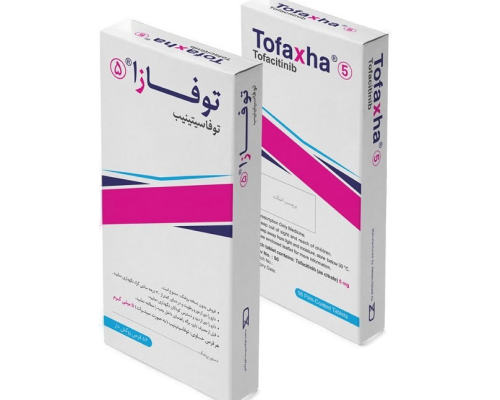1- What is Tofaxha?
Tofaxha tablet contains the active ingredient Tofacitinib indicated for the treatment of types of inflammatory diseases such as rheumatoid arthritis(RA), psoriatic arthritis(PsA), ulcerative colitis(UC) and polyarticular juvenile idiopathic arthritis.
2- Mechanism of Action
Tofaxha is an inhibitor of Janus kinases (JAKs). JAKs are intracellular enzymes transmitting signals arising from cytokine or growth factor-receptor interactions on the cellular membrane to influence cellular processes of hematopoiesis and immune cell function.
This drug changes the pathways of signal transduction at the site of the effect of these enzymes and prevents phosphorylation and activation of transmission routes of the message of the inflammatory factors and the gene expression associated with them.
3- Indications
Tofaxha is indicated for the treatment of the following inflammatory diseases:
- Rheumatoid Arthritis (RA)
- Psoriatic Arthritis (PsA)
- Ulcerative Colitis (UC) -a type of inflammatory bowel disease
- Polyarticular (affecting several joints) juvenile idiopathic arthritis
-Rheumatoid Arthritis (RA)
Tofaxha is indicated for the treatment of adult patients with moderately or severely active rheumatoid arthritis who have no response to methotrexate (MTX) or are intolerant to it. This drug can be used as monotherapy or in combination with methotrexate or other non-biologic disease-modifying antirheumatic drugs (DMARDs).
*Limitations of use:
Using this drug in combination with biologic DMARDs
– Psoriatic Arthritis (PsA)
Tofaxha is indicated for the treatment of adult patients with moderately or severely active psoriatic arthritis who have no response to methotrexate or are intolerant to it. This drug can be used as monotherapy or in combination with methotrexate or other nonbiologic disease-modifying antirheumatic drugs (DMARDs).
*Limitations of use:
Using this drug in combination with biologic DMARDs or with immunosuppressant such as azathioprine and cyclosporine is not recommended.
– Ulcerative Colitis (UC)
Tofaxha is indicated for the treatment of adult patients with moderately or severely active ulcerative colitis.
*Limitations of use:
Using this drug in combination with immunosuppressant such as azathioprine and cyclosporine is not recommended.
-Polyarticular juvenile idiopathic arthritis
Tofaxha is indicated for children aged over 2 with polyarticular idiopathic arthritis. In patients over 40 kg of weight oral tablets can be used.
*Limitations of use:
Using this drug in combination with biologic DMARDs or in combination with immunosuppressant such as azathioprine and cyclosporine is not recommended.
4- Dosage and Administration
Take Tofaxha as prescribed by your doctor.
-Rheumatoid Arthritis:
5 mg twice-daily.
-Psoriatic Arthritis:
5mg twice-daily.
-Ulcerative Colitis:
10 mg twice-daily for eight (8) weeks; 5mg or 10 mg twice-daily afterwards. In case of no response to10 mg twice-daily for sixteen (16) weeks, continuing therapy is not recommended.
– Polyarticular juvenile idiopathic arthritis:
“Children aged over 2 weighing 10 kg or more and young adults:
-10 to less than 20 kg: 3.2 mg twice daily [oral solution (1 mg/ml)]
-20 to less than 40 kg: 4 mg twice daily
“40 kg and more: 5 mg twice daily (oral tablets or oral solution)
*Tablets should be taken daily and at the same time of day (for example, one tablet in the morning and one tablet in the evening).
*Tofaxha can be taken with or without food.
*Tablets should be taken whole and intact and should not be crushed, chewed or dissolved.
- In case of infection while in therapy, it is recommended to interrupt the drug until the infection is thoroughly controlled.
“Titrating the dose in patients with juvenile idiopathic arthritis is as follows:
-In case of administering oral tablets given the patient weight, titrating the dose is necessary and will be once 5 mg daily:
- In case of using potent CYP3A4 inhibitors (like ketoconazole) or moderate CYP3A4 inhibitors with potent CYP2C19 inhibitors (like fluconazole)
- In patients with moderate liver impairment and/or moderate to severe kidney impairment
– Discontinue using the drug in patients with:
- Lymphocytes less than 500 cells/mm3
- ANC less than 500 cells/mm3
- ANC between 500 to 1000 cells/mm3 (temporarily discontinue and continue therapy in case ANC levels increase to more than 1000 cells/mm3)
- Hemoglobin levels less than 8 g/dl and/or decreased 2 g/dl hemoglobin levels. Discontinue therapy until hemoglobin levels turn normal.
5- Dosage Form and Strength
Tofaxha is available in 5 and 10 mg film-coated tablet for oral use.
6- Warnings and Precautions
-Serious Infections
There are reports of different types of infection in patients using this drug. The most
commonly reported infections include pneumonia, cellulitis, herpes zoster, urinary tract
infection, diverticulitis, appendicitis and tuberculosis. Due to reports on serious infections leading to the hospitalization of the patients, this drug should not be used in patients with an active, serious infection. If infection develops while in therapy, interrupt using the drug until the infection is fully resolved. It is also recommended to screen patients for tuberculosis before using this drug. Furthermore, patients should screen for latent tuberculosis at the initiation of treatment, they should be monitored for signs and symptoms of tuberculosis while in therapy.
-Risk of Death
Studies indicate that patients aged 50 and over with rheumatoid arthritis under treatment with high doses of Tofacitinib (10 mg twice daily) and have at least one factor affecting cardiovascular condition in comparison with patients under treatment with 5 mg twice daily are more at risks including death due to heart attacks.
-Malignancies and Lymphoproliferative Disorders
There have been reports of lymphoma and other types of cancer such as non-melanoma skin cancer (NMSC) in clinical studies with this drug. To this effect, the doctor should consider risks and benefits of using the drug in individuals with prior history of malignancy or prior history of a successfully treated non-melanoma skin cancer.
-Gastrointestinal Perforations
Tofacitinib should be used with caution in patients with the risk of gastrointestinal perforation and patients with prior history of diverticulitis or using non-steroidal anti-inflammatory drugs (NSAIDs). In case of symptoms indicating gastrointestinal disorders while in therapy, call your doctor at once.
-Laboratory Abnormalities
*Decreased lymphocytes (a type of white blood cells)
Due to decreased blood lymphocytes (lymphopenia) and increased risk of infection, it is recommended to monitor the patient lymphocyte counts before initiating treatment. After initiating treatment, monitor lymphocyte counts every three months. In case absolute blood lymphocyte count drops to less than 500 cells/mm³, treatment with this drug should be interrupted.
*Decreased neutrophils (a type of white blood cells)
Since using Tofacitinib is associated with increased incidence of decreased blood neutrophils (neutropenia), it is recommended to monitor neutrophil counts before starting treatment and after four to eight (4-8) weeks of treatment and every three months thereafter. In case absolute neutrophil count (ANC) drops to less than 500 cells/mm³, continuing treatment with this drug is not recommended. Patients with a persistent neutrophil counts of 500-1000 cells/ mm³, should stop using the drug until neutrophil counts is equal to or greater than 1000 cells/ mm³.
*Anemia
Initiating this drug in patients with a hemoglobin level less than 9 g/dL is not recommended. Treatment with Tofacitinib should be stopped if hemoglobin levels are decreased or are less than 8 g/dL, or hemoglobin level drops more than 2g/dL on treatment. It is therefore, recommended to monitor hemoglobin level of the patient before initiating the drug and after four to eight (4-8) weeks of treatment and every three months thereafter.
*Increased Liver Enzymes
Tofacitinib can increase liver enzymes up to 3 times normal levels. To this effect, periodically monitor liver enzymes in patients taking this drug. In case of increased liver enzymes, the dosage may be reduced or therapy temporarily discontinued with the doctor discretion.
*Lipid Elevations
Treatment with this drug can be associated with increases in cholesterol: low-density lipoprotein (LDL) and high-density lipoprotein (HDL). It is recommended to assess lipid parameters four to eight (4-8) weeks after initiating therapy.
-Risk of Blood Clots:
Cases of thrombosis including pulmonary embolism, deep vein thrombosis and arterial thrombosis have been reported in patients using Tofacitinib. The incidence rate is higher in patients over 50 and taking Tofacitinib 10 mg twice daily. Contact your doctor in case of any problems including breathing difficulties, chest pains and bloody cough.
-Vaccines
- Inactivated vaccines: Immunosuppressant may decrease the therapeutic effects of inactivated vaccines. To this effect, inoculate up to two (2) weeks before initiating Tofacitinib, and also in case of inoculation during treatment with Tofacitinib, reinoculate three months after stopping Tofacitinib. • Live vaccines: Immunosuppressant may decrease the therapeutic effects of live vaccines. To this effect, avoid using live vaccines while under treatment with Tofacitinib and for three months after stopping it.
– Lactose Intolerance
Tell your doctor if you are suffering from lactose intolerance, since Tofaxha contains lactose monohydrate.
7- Adverse Reactions
Very common (more than 10 percent of patient population)
including:
-Infection
-Respiratory: Nasopharyngitis
Common (1 to 10 percent of patient population) including:
-Cardiovascular: Increased blood pressure
-Dermatology: Skin rash, acne vulgaris
-CNS: Headache
-Gastrointestinal: Diarrhea, nausea, gastroenteritis
-Urinary Tract: Urinary tract infection
-Hepatic: Increased alanine transaminase(ALT) levels (one of liver enzymes)
-Infection: Herpes zoster
-Kidney: Serum creatinine elevations
-Respiratory: Upper respiratory tract infection
Less common (less than 1 percent of patient population) including:
Peripheral Edema, Fatigue, Insomnia, Numbness, Rash, Pruritus, Abdominal Pain,
Vomiting, Diverticulitis, Indigestion, Muscle Pain, Joint Swelling, Tendonitis, Pain, Cough,
Breathlessness, Interstitial Lung Disease (ILD), Liver Enzymes Elevations.
8- Drug Interactions
Since this drug can interact with other drugs, make sure to tell your doctor about the drugs you take before starting Tofaxha. Tell your doctor in case you orally take any of the following drugs since concurrent use of any of these drugs with Tofaxha possibly increase the risk of adverse reactions especially infection:
-Antibiotics such as Clarithromycin and Rifampin used to treat bacterial infections.
-Fluconazole, Ketoconazole, Clotrimazole, Itraconazole and Voriconazole used to treat fungal
infections.
* Concurrent use of Tofaxha with immunosuppressive agents such as Azathioprine, Mercaptopurine, Cyclosporine and Tacrolimus is not recommended.
* An increased risk of serious infection is possible in patients receiving corticosteroid drugs such as Prednisolone.
9- Use in Specific Populations
*Pregnancy
There is limited information on the use of this drug in pregnancy. At present, therefore, it is not recommended in pregnancy.
*Nursing
There is insufficient data regarding the amount of drug excreted in mother milk. Given the risk of serious adverse reactions in newborns, using this drug while nursing is not recommended.
*Use in diabetics
Given the increased risk of infection in diabetics, caution should be used when administering this drug.
*Renal impairment
It is recommended to adjust the dose in patients with mild to severe renal impairment. For patients with moderate or severe renal impairment taking the drug as 5 mg tablet twice-daily, reduce to 5 mg once-daily; accordingly, for 10 mg twice-daily, reduce to 5mg twice-daily.
*Hepatic impairment
For patients with moderate hepatic impairment taking the drug as 5 mg tablet twice-daily, reduce to 5 mg once-daily; and accordingly, for 10 mg twice-daily, reduce to 5mg twice-daily.
-It is not recommended to use this drug in patients with severe hepatic impairment.
-There are no studies regarding safety and efficacy of Tofacitinib in patients screening positive for hepatitis B or C.
*Respiratory impairment
Given the high incidence of infection, practice caution in administering Tofacitinib in patients with a history of chronic lung diseases or interstitial lung disease (ILD).
10- Drug Overdose
In case of an overdose, contact healthcare providers or poison control centers so that necessary measures to monitor signs and symptoms are taken.
11- Missed Dose
In case you forget one dose, take it as soon as you remember. In case it is almost time for the next dose, skip the missed dose and take the next dose as scheduled.
12- Storage
Keep away from light and moisture, store below 30˚C. Keep out of sight and reach of children.
13- D.Nurse-Patient Helpline Team
You can contact Drugs Expert Consultation Center at 0935 220 3041-4 to get answers to your inquiries and also get to know nursing support centers in your city.Expert Consultation Center is always ready to answer the questions of our valued customers.



